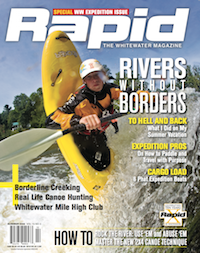Rocks are often viewed as a river hazard, creating undercuts and sieves. What many paddlers don’t realize is that rocks can be very useful features on the river. Exposed rocks beside a drop can make the ideal launch ramp. Sliding across them may be the only way to avoid a nasty pin. Once you figure out how to make the most out of the river’s natural rock garden your river running and creeking will groove to new heights.
Use ‘em and Abuse ‘em
Using rocks to your advantage basically means getting away from the main flow and plowing up onto the edge of a rock that sits at water level, close to a drop. By getting your boat out of the water and up onto a nearby rock you can slide past a potential pin spot or undercut ledge that the main flow would otherwise push you into. The best rocks are smooth, around water level, and relatively close to the drop. Plowing up onto a sticky or jagged rock will kill your speed (if not stop you completely) and throw you off line. Smooth rocks at the lip of a drop will often auto-boof you to safety, allowing you to land away from the meatiest part of the hole at the bottom.
Body Positioning
As with any river-running skill you’ll want to maintain a forward paddling position. The trouble with leaning back is that you’ll be less balanced with excess weight on your stern. This increases the likelihood of your stern edges catching and is a more dangerous position if you happen to flip. To get yourself further up on a rock you can move your body weight to a less aggressive neutral position as long as you get your weight forward again before you land.
The Approach
If you plan to boof straight out from the drop, aim to make contact with the rock at about a 20- to 30-degree angle, with speed. Before your bow makes contact with the rock make sure your weight is forward and you’re ready with a stroke on the side away from the rock. If you plan to land at the bottom of the drop pointing to the left or right you’ll need to adjust the angle at which you approach the rock. As a general rule, making contact with any rock will straighten your boat’s angle and it will be difficult to angle away from the rock. This means that if you make contact with a rock on the left it won’t be easy to land pointing hard right.
Drying Out
Catch too much rock and you’ll lose all of your momentum, which often results in teeter-tottering over the lip of the drop. There are times when you’ll want to purposefully dry out, but for the most part drying out at the wrong time will blow your line. It’s important to understand the more rock you catch, the further you’ll slide back down into the main flow. When scouting a drop, look at where you plan on landing and consider the angle that you’ll slide off the rock. This angle will dictate how far you slide back into the main current.
Sound Check
Pick a safe drop and spend some time figuring out how your boat reacts to slid- ing on rock. Try taking different approaches to the rock, using lots of speed or no speed, lots of angle, straight on, taking a fast stroke, slow stroke, et cetera. With a little bit of practice you’ll be rocking out in no time!
Kelsey Thompson is a multi-time Canadian national freestyle medalist and Wave Sport team paddler, not to mention a music video producer.

This article first appeared in the Early Summer 2008 issue of Rapid Magazine.




